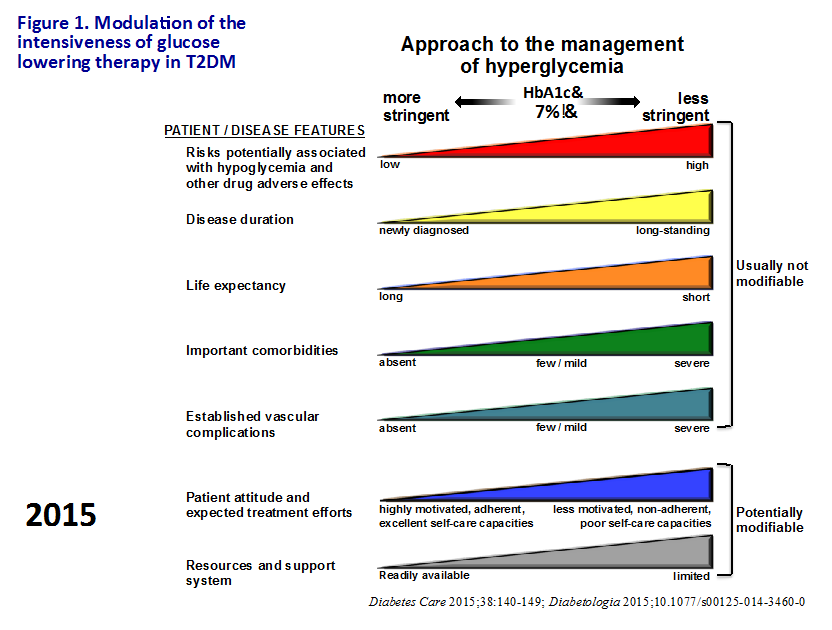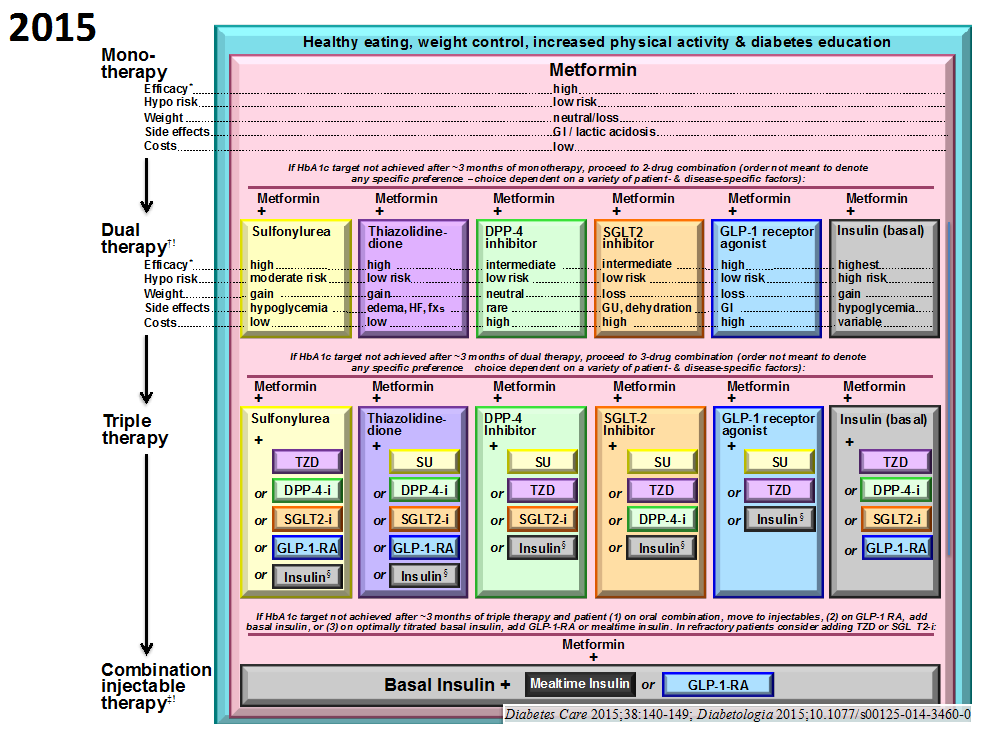Newer Agents in Type 2 Diabetes
A 61-year-old man has a 12-year history of type 2 diabetes. Other medical problems include hypertension, hyperlipidemia, coronary artery disease (CAD), diastolic dysfunction, gout, and benign prostatic hyperplasia (BPH). His current antihyperglycemic regimen consists of metformin and sitagliptin. His blood glucose levels at home have increased over the past year, so that he is now running 150-170 mg/dl range fasting, and frequently >200 mg/dl during the day. His A1c, which had been previously maintained between 7.0% and 7.5%, has increased over the past six months to 8.3%.
Past Medical History:
Hypertension
Hyperlipidemia
CAD s/p left anterior descending (LAD) artery stent (drug-eluting) three years ago (last nuclear stress test without ischemia)
Diastolic dysfunction by echocardiogram
Gout
BPH
Cholecystectomy
Medications:
Metformin 1,000 mg BID
Sitagliptin 100 mg QD
Metoprolol XR 100 mg QD
Lisinopril 10 mg QD
Atorvastatin 40 mg QD
Allopurinol 300 mg QD
ASA 81 mg QD
Social History: Former smoker; no excess alcohol. Works as an accountant. Married with two grown children.
Family History: Type 2 diabetes in both parents.
ROS: No chest pain but mild exertional dyspnea. No edema. Mild obstructive voiding symptoms.
Physical Examination: Obese man in no apparent distress. Body mass index (BMI) 35.2 kg/m2. BP 146/92. HR 72 regular RR 18 afebrile.
No jugular venous distension. Carotid upstrokes normal.
Lungs clear
Cardiac sounds normal
Abdomen obese but no masses or tenderness
Extremities: Trace edema
Neurological Exam: Non-focal
Data
Normal chemistries; estimated glomerular filtration rate (eGFR) >90
HbA1c 8.3%
Low-density lipoprotein (LDL) 63, high-density lipoprotein (HDL) 45, TGs 167
Urine microalbumin: negative
Electrocardiogram: Left ventricular hypertrophy (LVH) but no ischemic changes
Assessment: 61-year-old man with suboptimal blood glucose control on dual therapy with metformin and a DPP-4 inhibitor, in the setting of well-controlled hypertension and hyperlipidemia and a history of CAD and diastolic dysfunction.
Discussion Questions
-
What is his HbA1c goal?
Choosing an HbA1c target is the first step in this patient's diabetes care – to determine how much further glucose lowering is optimal for him. Based on his age and prevalent CAD, several randomized controlled clinical trials have demonstrated no cardiovascular advantage from intensive glucose control. Instead, a more moderate approach, with an HbA1c target of 7-7.5% would seem optimal. This will minimize the risk of developing microvascular complications and not aggravate the risk of cardiovascular events. So, he needs an antihyperglycemic drug that is apt to reduce his HbA1c by somewhere between 0.8-1.3%. A useful figure that delineates the patient and disease features that help the clinical in determining optimal HbA1c ranges for patients has been published by the American Diabetes Association (ADA) and European Association for the Study of Diabetes (EASD):
(Click to Enlarge)
Reproduced with permission from Inzucchi SE, Bergenstal RM, Buse JB, et al. Management of hyperglycemia in type 2 diabetes, 2015: a patient-centered approach: update to a position statement of the American Diabetes Association and the European Association for the Study of Diabetes. Diabetes Care 2015;38:140-9.
-
What are the treatment options for his diabetes at this juncture?
According to the updated ADA-EASD position statement, treatment options include the addition of a sulfonylurea, a thiazolidinedione, an SGLT-2 inhibitor or basal insulin. Another strategy is to switch his DPP-4 inhibitor to a GLP-1 receptor agonist, using that in combination with metformin, and then add one of the 4 drug classes above.
(Click to Enlarge)
Reproduced with permission from Inzucchi SE, Bergenstal RM, Buse JB, et al. Management of hyperglycemia in type 2 diabetes, 2015: a patient-centered approach: update to a position statement of the American Diabetes Association and the European Association for the Study of Diabetes. Diabetes Care 2015;38:140-9.
Each choice has unique advantages and disadvantages:
- Sulfonylureas (glyburide, glipizide, glimepiride): These insulin secretagogues will reduce HbA1c about 1% and get him to target. It will, however, likely predispose him to hypoglycemia and some weight gain. In addition, of all the drug classes we use in T2DM, the sulfonylureas are likely associated with the greatest secondary failure rates, likely related to progressive beta cell functional decline.
- Thiazolidinediones (pioglitazone, rosiglitazone): These insulin sensitizers would also reduce HbA1c about 1% and do not carry additional risk of hypoglycemia. However, they are associated with weight gain and may increase the risk of edema and heart failure (due to effects on sodium handling by the nephron). In women, they are also associated with an increased risk of bone fractures. This class may be associated with the least secondary failure rates, but they have not been compared in this regard to all other classes. Pioglitazone may reduce major adverse cardiac events (MACE), but rosiglitazone has been mired in controversy because of some data suggesting the opposite effect.
- SGLT-2 inhibitors (canagliflozin, dapagliflozin, empagliflozin): These are glucosuric agents that reduce HbA1c less than 1%. They are also not associated with an increased risk of hypoglycemia and have modest benefits on body weight and blood pressure (the latter through a mild diuretic effect). They increase the risk of genital mycotic infections and possible urinary tract infections and may lead to symptoms of dehydration in some patients.
- GLP-1 receptor agonists (exenatide, liraglutide, albiglutide, dulaglutide): These injectable drugs activate GLP-1 receptors and serve to increase insulin secretion in a glucose-dependent fashion, reduce glucagon secretion, delay gastric emptying and reduce appetite. In addition to lowering HbA1c 1% or more, the class leads to weight loss, which can ben substantive in some, and may have beneficial effects on several cardiovascular (CV) risk factors (blood pressure, lipids.) They are associated with gastrointestinal side effects and requires injection training.
- Basal insulin (glargine, detemir, NPH) is associated with weight gain and hypoglycemia and increases the need for glucose monitoring. This strategy requires more education than the others, particularly in the avoidance of hypoglycemia.
-
How do this patient's comorbidities influence drug choice?
Given his underlying CAD, it might be beneficial to avoid any drug that might aggravate CV risk. Sulfonylureas have been associated with increased CV mortality in several retrospective studies when compared to metformin. However, in most clinical trials, they appear to have a neutral on MACE. These agents, however, increase the risk of hypoglycemia, which itself has been associated with adverse CV outcomes. Accordingly, it may be best to avoid these agents (as well as insulin) in this patient. Pioglitazone could be used but would increase the risk of worsening edema and may aggravate the risk of clinical heart failure in this patient with diastolic dysfunction. (It should be noted that saxagliptin, another DPP-4 inhibitor similar to sitagliptin, has also recently been suggested to increase heart failure hospitalizations, although overall this drug class appears to have a neutral effect on MACE.) An SGLT-2 inhibitor is a newer, attractive option and may lead to some weight loss and reduction in BP. Its effects on CV outcomes are unclear, however, with long-term CV outcomes trials underway. Switching his DPP-4 inhibitor sitagliptin to an injectable GLP-1 agonist is unlikely to reduce his HbA1c more than slightly, and a third agent would likely be necessary. However, the GLP-1 agonists would likely allow this patient to lose more weight. As with the SGLT2 inhibitors, we don't know yet about their impact on MACE. Cost is a major concern with diabetes medications, with newer products often 100-fold more expensive than generic drugs. Whether this price differential is worth the advantages they bring remains unclear. A long-term comparative efficacy trial, GRADE, is currently underway and will be comparing clinical outcomes with several of these agents after metformin monotherapy.The author of this Expert Analysis would select therapy depending in part on a conversation with the patient to learn about his views regarding side effects and price. All things being equal, if cost was not a concerned, this author would leave him on the metformin-sitaglipin combination and consider a trial of an SGLT-2 inhibitor, and would obtain a follow-up HbA1c in three months to see if this intervention gets him back to the 7-7.5% range to which he was accustomed.
Keywords: Abdomen, Adamantane, Allopurinol, Appetite, Arteries, Benzhydryl Compounds, Blood Pressure, Blood Glucose, Body Mass Index, Chest Pain, Cholecystectomy, Comorbidity, Coronary Artery Disease, Dehydration, Diabetes Mellitus, Type 2, Dipeptides, Diuretics, Drugs, Generic, Dyspnea, Edema, Electrocardiography, Exercise Test, Fasting, Female, Follow-Up Studies, Fractures, Bone, Gastric Emptying, Glipizide, Glomerular Filtration Rate, Glucagon, Glucagon-Like Peptide 1, Glucose, Glucosides, Glyburide, Goals, Gout, Heart Sounds, Heart Failure, Heptanoic Acids, Hospitalization, Humans, Hyperglycemia, Hyperlipidemias, Hypertension, Hypertrophy, Left Ventricular, Hypoglycemia, Hypoglycemic Agents, Immunoglobulin Fc Fragments, Insulin, Insulin, Long-Acting, Lipids, Lipoproteins, HDL, Lipoproteins, LDL, Lisinopril, Male, Metformin, Metoprolol, Nephrons, Parents, Peptides, Prostatic Hyperplasia, Pyrazines, Pyrroles, Receptors, Glucagon, Recombinant Fusion Proteins, Retrospective Studies, Risk Factors, Running, Sodium, Stents, Sulfonylurea Compounds, Thiazolidinediones, Thiophenes, Triazoles, United States, Urinary Tract Infections, Weight Gain, Weight Loss
< Back to Listings


